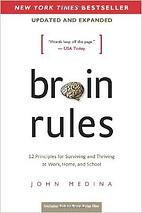 Brain Rules: 12 Rules for Surviving and Thriving at Work, Home, and School
Brain Rules: 12 Rules for Surviving and Thriving at Work, Home, and School
An Executive Summary by MyGuru
Introduction
Many people believe that a person’s intelligence is something given at birth. It’s a fixed trait, and it endows you with a certain “max potential” for understanding and learning new concepts. However, research conducted over the past decade has increasingly shown that this is more false than true.
While it may be true that some people are born with a higher or lower IQ, it is now generally accepted science that the brain is quite malleable, meaning the physical brain can literally change and improve a person's cognitive function as a result. One common way to envision what this means is to imagine that your brain is, in many important ways, like a muscle. If you use it in specific ways, it will grow and become stronger and more efficient. Throughout one’s life, there can be changes in the brain such as growth of new neurons and new connections between existing neurons, which can drive improved cognitive function in general and which lie behind the acquisition of new skills.
There is a lot we have learned about the brain in the past 10 years.
In Brain Rules, John Medina (a molecular biologist and lifeline student of the brain) explains what’s happening inside our heads, and provides practical tips and advice for how to harness your brain’s malleability to improve your performance at work, school, home, and anywhere else. He introduces the reader to a variety of insights about the brain, some of which are intuitive, but many of which are not, including:
- The more you exercise, the higher your cognitive function, which I did not find to be all that intuitive.
- Sleep is more directly linked to your ability to learn than you most likely realize, which I found somewhat intuitive, but which the average student and parent probably forgets about all too easily.
- Stress can be a serious impediment to learning, though harnessed well, can also support learning. This one, for example, seemed more intuitive to me.
Executive Summary
The book is structured around 12 “rules” for getting the most out of your brain. These rules are:
- Recognize that your brain evolved to help you survive in an intense outdoor environment that is very different from the world we live in today (at least different for most of us reading this summary). This has implications for understanding your behavior and ability to learn.
- Simply put, exercise helps your brain perform better. More exercise = higher cognitive function.
- In general, more sleep = higher cognitive function
- In general, less stress = higher cognitive function
- Every brain is wired differently, which means you will learn in different ways and at different rates from others.
- We find it hard to pay attention to boring things (though what one of us considers boring is based on personal experience) and although we do a lot of it, multi-tasking is something the brain really can’t do well.
- Repeat to remember. Our short-term memory is enhanced through extensive repetition upon learning something new for the first time, and by adding additional information to the desired memory (to use Medina’s example, you don’t just say “her name is Mary,” instead you say to yourself “(her name is Mary, and Mary is wearing a blue dress, and my favorite color is blue).
- Remember to repeat. Our long-term memory is enhanced through repetition in regular intervals after initial exposure.
- When we engage more of our senses, it’s easier to understand and remember things
- Vision is the most powerful sense when it comes to learning
- Male and female brains do learn differently
- Our brains evolved to support curiosity and learning new things
In each chapter, Medina spends a significant amount of time explaining and discussing the rule, and usually ends the chapter with some “key tips” for how to start applying the rule in your own life. In our full summary, we’ll cover the key points in each chapter, review Medina’s key takeaways, and provide some simple analysis and perspective as well, particularly as it applies to students looking to improve their academic performance.
Note that Medina provides free chapter summaries on his web-site as well as the introduction to the book.
Rule #1: Your Brain Evolved
To help readers understand the first rule, Medina notes that, going back tens of thousands of years, there were two ways to win in the harsh environment in which we evolved. We could have a) become stronger and faster or b) smarter. Our species chose the latter path, and luckily for us, it worked. In this chapter, Medina explore how we got smarter and how it helped us.
He talks about five ways in which our growing intelligence helped us conquer our environment:
We can make things up. We can imagine different scenarios, develop concepts and frameworks, and make plans based on our creativity.
We “adapted to variation.” Other species died out because, for example, the world got colder, changing their environment. But, we would use our brains to “adapt” to changes in the environment. He notes that 100,000 years ago, temperatures varied a lot. Members of our species could be born in arctic like conditions, but then decades later, face extremely hot weather. There was a lot of environmental instability. We were able to successfully deal with it. Many species were not.
How did we do it?
We adapted to variation, meaning we evolved to favor those members of our species who were comfortable rapidly solving new problems or learning from mistakes. Those who could do these things passed on their genes. Over time, our species became more flexible, better at solving problems, and generally smarter. Medina notes that the key factors here, which will become more relevant in later chapters, were our ability to store a lot of facts in our brain about the world in which we were living, but then to learn to “improvise off of that database” so that we could identify when we’ve made mistakes, and then learn from them and do things differently and better in the future.
Our brains grew bigger and bigger. Medina also notes that it wasn’t just that our brains evolved faster and made us smarter than other chimpanzees. Something obviously more remarkable than that happened. Our “adapting to variation” was the context for our increased intelligence, but it doesn’t really explain the ability to visualize concepts, reason with symbols, and ultimately invent calculus (his example). So what happened, and what can we learn from it?
The book tells the story of a popular construction worker who lived around 1850, and endured an injury that involved a pole getting stuck quite literally through his head. Luckily, the pole destroyed one particular area of the brain, called the prefrontal cortex, but nothing else. He survived. But, he also became highly impulsive and unable to control his emotions, because the pre-frontal cortex happens to control what are called our “executive functions,” or our ability to solve problems, maintain attention, and inhibit emotional impulses. We actually have a podcast episode on this web-site about executive function skills and how important they are to academic performance
Medina uses this story to launch into a description of our “three brains.” The pre-frontal cortex is actually the most recent addition. In fact, our brain has been evolving for millions of years, and the oldest part is called the “neural stem” and is sometimes called the “lizard brain” because lizards have a similar structure in their head as well. This part of your brain controls the basic functions that keep you alive: breathing, heart rate, etc.
On top of the “neural stem” is the “mammalian brain.” We share this structure with many other mammals, and it regulates impulses you might easily associate with other mammals and animals, like fighting, fleeing, feeding, and reproducing – but not deep thinking. Medina goes into detail about various parts of the “mammalian brain,” such as the amygdala, which controls emotions and related memories, the hippocampus, which converts short-term into long-term memories and will be particularly relevant in his chapter on memory, and the thalamus, which controls senses.
One top of all of this is the “human brain” or “cortex,” which is in constant deep electrical communication with other parts of the brain. It is responsible for all of the activities that are unique to humans, like speech, vision, the aforementioned executive functions, and various types of memory.
Finally, we also survived by learning to cooperate. It would not have been possible to survive in the harsh environments in which we evolved without cooperating in truly unique ways. One human could not fight a wooly mammoth. But by cooperating, 2-3 of us could. The only way to learn to cooperate to conquer the environment was to develop the ability to comprehend shared goals, understand other peoples’ perspectives, and establish systems for rewarding and punishing. We had to be able to try to understand other people and predict their feelings and how they would act. Medina calls this ability to predict the Theory of Mind, notes that it takes a tremendous amount of brain power, and that really no other creature comes close to having this type of ability.
Summary of chapter #1
So, now we know that the brain was designed to solve problems in a harsh, always changing environment where we humans were always moving around. We started with a lizard brain, but added more complex parts on top over time, and by adapting to change itself, genes were selected that allowed us to become increasingly good at solving problems. Our ability to use symbolic reasoning to understand other people’s perspectives and motivations is uniquely human, and likely is what allowed us to begin to cooperate so well that we were ultimately able to take over the earth.
Why did Medina walk through all of this detail on how our brains evolved? Because it provides valuable information about how humans acquire knowledge, and establishes a baseline from which the rest of the brain rules will emerge.
In future chapters, there will be some clear insights and practical tips that naturally unfold from the narrative. For example, in the next chapter, we’ll learn that the more you exercise, the better your brain functions. It will be very straight forward.
In this first chapter, however, the implications are less direct. Here are two for the reader to consider:
- Note the importance of the pre-frontal cortex, which controls our executive functions. The ability to regulate your emotions, stay on take, pay attention, etc. are skills that can be developed and can play a hugely important role in the success of a student. Many researches consider these skills far more important to academic success than IQ!
- Note the importance of the Theory of Mind and the ability to take other’s perspectives. Whether you are working with a classmate or trying to understand a teacher’s perspective, try different ways to think about where the other person is coming from.
In this next chapter, we’ll learn about the importance of exercise to the function of the human brain.
Do you like what you are reading so far? Here are some ways to explore this book in more detail:
Browse John Medina's web-site
Buy a summary of Brain Rules from Amazon
Buy the full book from Amazon
Click here to return to our recommend reading page, or we encourage you to read our blog on improving academic performance.

